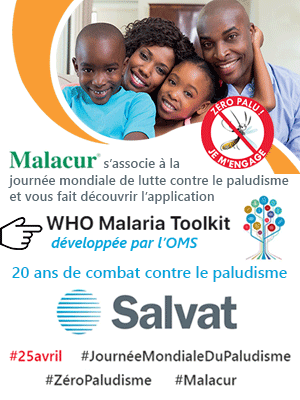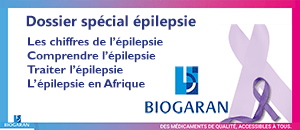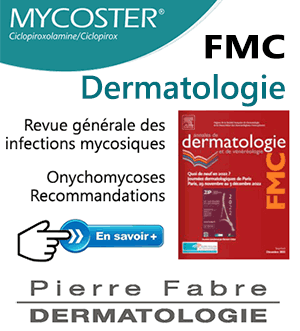← retour Santé tropicale
Accès aux sites pays ![]()
![]() BENIN
BENIN![]() BURKINA FASO
BURKINA FASO![]() CAMEROUN
CAMEROUN![]() CENTRAFRIQUE
CENTRAFRIQUE![]() CONGO
CONGO![]() COTE D'IVOIRE
COTE D'IVOIRE![]() GABON
GABON
![]() GUINEE
GUINEE![]() MADAGASCAR
MADAGASCAR![]() MALI
MALI![]() R.D. CONGO
R.D. CONGO![]() SENEGAL
SENEGAL![]() TOGO
TOGO
← retour Santé tropicale
Accès aux sites pays ![]()
![]() BENIN
BENIN![]() BURKINA FASO
BURKINA FASO![]() CAMEROUN
CAMEROUN![]() CENTRAFRIQUE
CENTRAFRIQUE![]() CONGO
CONGO![]() COTE D'IVOIRE
COTE D'IVOIRE![]() GABON
GABON
![]() GUINEE
GUINEE![]() MADAGASCAR
MADAGASCAR![]() MALI
MALI![]() R.D. CONGO
R.D. CONGO![]() SENEGAL
SENEGAL![]() TOGO
TOGO

Publié dans Médecine d'Afrique Noire 5904 - Avril 2012 - pages 181-186
 Sensibilité aux antibiotiques des sérotypes Typhi, Paratyphi A, B et C de Salmonella à Bangui
Sensibilité aux antibiotiques des sérotypes Typhi, Paratyphi A, B et C de Salmonella à BanguiAuteurs : Mossoro-kpinde CD, Lango-Yaya E, Mossoro-Kpinde HD, Yandoumba M, Nambei SW, Koffi B, Le Faou A - Centrafrique
Contexte : Les fièvres typhoïdes et paratyphoïdes constituent un important et persistant problème de santé publique dans les pays en voie de développement. L’émergence chez les sérotypes de Salmonella de souches multirésistantes aux antibiotiques couramment utilisés menace l’efficacité de leur traitement.
Objectif : Evaluer la sensibilité aux antibiotiques des sérotypes Typhi et Paratyphi A, B et C de Salmonella enterica isolées à Bangui en 2010.
Matériel et méthodes : Cette étude transversale s’était déroulée en 6 mois. Elle avait concerné 1517 coprocultures (de selles) de patients adressés au laboratoire et 509 hémocultures (de sang) de patients admis dans les 3 grands hôpitaux de Bangui. Les souches des sérotypes Typhi et Paratyphi A, B, et C provenant d’autres prélèvements (urine, liquide cérébro-spinal, sécrétion vaginale) ont également été incluses dans cette étude. L’isolement, l’identification et les antibiogrammes des souches de Salmonella ont été obtenus selon les procédures standardisées.
Résultats : Durant la période d’étude, 95 souches des 4 sérotypes étudiés de Salmonella ont été isolées : 59 de 1517 coprocultures (3,9%) contre 28/509 en hémoculture (5,5%) et 8 d’autres échantillons (urines, liquide céphalorachidien et sécrétions vaginales). La proportion de résistance la plus élevée était de 72,1% ; elle concernait l’ampicilline. La triple résistance (ACSu, à l’ampicilline, au chloramphénicol et au cotrimoxazole) et la pentarésistance (ACSSuT, à l’ampicilline, au chloramphénicol et au cotrimoxazole, à la streptomycine et aux tétracyclines) avaient atteint 20%. La résistance à la ciprofloxacine était faible. Aucune résistance à la ceftriaxone n’avait été observée.
Ces 2 derniers antibiotiques conviennent mieux au traitement.
Background: Typhoid and paratyphoid fevers are a major and persistent public health problem in developing countries. The emergence of Salmonella multi-resistant strains to antibiotics threatens the efficiency of their treatment.
Objective: To determine the sensitivity to antibiotics of the serovars Typhi and Paratyphi A, B and C isolated in Bangui in 2010.
Material and methods: This cross-sectionnal study was conducted in 6 months. It had concerned 1517 stools samples (from faeces) and 509 blood cultures obtained from patients admitted in the three major hospitals of Bangui. The Typhi and Paratyphi A, B and C strains isolated from samples originated from diverse sources (urine, Cephalospinal Liquid and vaginal secretion) were also included in this study. The isolation, the identification and the antibiograms were performed according to the standardized procedures.
Results: During the study period, 95 strains of the 4 serotypes (Typhi and Paratyphi A, B, and C) have been isolated : coprocultures allowed isolating 59 serotypes from the 1517 stools (3.9%), 28 serotypes were isolated from 509 blood by hemoculture (5.5%) and 8 from other diverse sources (urine, cephalospinal liquid and vaginal secretion). The proportion of highest resistance was 72.1%; It concerned the ampicillin. Triple resistance (ampicillin, chloramphenicol and cotrimoxazol or ACSu) and the penta resistance (ampicillin, chloramphenicol, cotrimoxazol, streptomycin, tetracyclin or ACSSuT) represented 20%. Resistance to ciprofloxacine was low and no resistance to ceftriaxone was observed.
These last two antibiotics are better suited to the treatment.
Cet article est actuellement coté ![]() (2,0 étoiles) par les abonnés de Médecine d'Afrique Noire.
(2,0 étoiles) par les abonnés de Médecine d'Afrique Noire.
Il a été consulté 3126 fois, téléchargé 103 fois et évalué 2 fois.
2 commentaires ont été postés à propos de cet article
 Obtenir l'article intégral en PDF
Obtenir l'article intégral en PDF
Plus d'articles Centrafricains - Plus d'articles panafricains
Restez informés : recevez, chaque mercredi, la lettre d'informations de Santé tropicale. Inscriptions
Ce contenu gratuit vous est destiné :








![]() Adresse
Adresse
![]() Téléphone
Téléphone
![]() Contactez-nous
Contactez-nous
Actualités
Articles médicaux